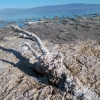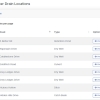
Proper inspection and maintenance of stormwater infrastructure, especially catch basins and culverts, is vital to ensure effective drainage performance, prevent flooding, and comply with Municipal Separate Storm Sewer System (MS4) regulations. These structures are often the first and most visible components of a town or city's stormwater network, and their condition directly affects water quality and hydraulic function.
This article provides an overview of how to inspect catch basins and culverts in the field, common issues to watch for, and how regular inspection aligns with MS4 program goals.
Catch basins (also known as storm drains or drop inlets) are designed to collect runoff from impervious surfaces and direct it into the storm sewer system. They typically contain a sump to capture sediment and debris before the flow is discharged downstream.
Culverts are pipe or box structures that allow stormwater to flow beneath roadways, driveways, or embankments. They are critical for maintaining uninterrupted drainage pathways and preventing washouts.
Poor maintenance of either component can lead to blockages, localized flooding, road damage, and pollutant discharges, all of which are red flags in an MS4 audit.
Under the Clean Water Act, municipalities covered by MS4 permits must develop a Stormwater Management Program (SWMP) that includes:
Annual inspections of stormwater structures
Documentation of maintenance activities
Identification and elimination of illicit discharges
Pollution prevention measures
Field inspections of catch basins and culverts directly support these requirements by:
Identifying sediment accumulation, which can impair pollutant capture efficiency
Detecting structural failures or misalignments
Spotting evidence of illegal dumping or illicit connections
Documenting field conditions to trigger maintenance or repair work
Safety First
Use traffic cones or signage if working roadside
Wear hi-vis clothing, gloves, and eye protection
Never enter a confined space without proper training and equipment
Visual Inspection
Check for debris blocking the grate or curb inlet
Look for signs of ponding or standing water near the basin
Inspect the interior structure for cracks, corrosion, or exposed rebar
Sediment Depth Measurement
Use a dipstick or measuring rod to assess sediment buildup
If the sump is over 50% full, schedule cleaning
Outflow and Connection Check
Ensure water flows freely out of the basin during a flow test
Look for oil sheen, strong odors, or unusual colors, which may indicate illicit discharges
Record Observations
Note the basin’s ID, location, date of inspection, and any issues found
Include photos for documentation
Log into asset management software (e.g., Roadwurx or Cartegraph)
Locate and Access Both Ends
Verify inlet and outlet locations
Remove vegetation or debris that blocks visibility
Structural Integrity
Inspect for joint separation, cracks, pipe corrosion, or collapsing sections
For metal pipes, check for invert rusting and undermining
Flow Obstructions
Check for sediment plugs, branches, trash, or animal nests
Observe water movement - slow or no flow may indicate blockage
Scour and Erosion
Examine the headwalls and wingwalls for undermining
Look for erosion downstream of the outlet that could destabilize the structure
Hydraulic Performance
During wet weather, assess whether the culvert is adequately conveying stormwater
If overtopping or backwater conditions exist, it may be undersized or compromised
Inspection Recordkeeping
Capture the condition with photos and notes
Assign a priority level for follow-up
Record GPS coordinates if unmapped
Use GIS-based field apps or mobile-friendly asset management systems to log inspections in real time
Establish an inspection rotation, which is especially critical or older assets may need semiannual checks
Train personnel in illicit discharge detection, confined space awareness, and stormwater permit requirements
Include catch basins and culverts in your municipality’s Operation & Maintenance (O&M) Plan
Catch basins and culverts are foundational components of a functioning stormwater system. When these structures are neglected, communities face increased flooding risk, infrastructure deterioration, and regulatory violations. By implementing a structured inspection program and aligning with MS4 compliance strategies, municipalities can reduce long-term costs, improve water quality, and uphold environmental responsibility.
 Wetlands are often described as the kidneys of the watershed because they filter, slow, and transform the water that passes through them in ways that …
Wetlands are often described as the kidneys of the watershed because they filter, slow, and transform the water that passes through them in ways that …
 Field inspections of catch basins, manholes, culverts, and outfalls form the foundation of responsible stormwater management. These routine checks giv…
Field inspections of catch basins, manholes, culverts, and outfalls form the foundation of responsible stormwater management. These routine checks giv…
 Habitat disruption around drainage structures is often subtle at first, and many of the earliest signs tend to appear during ordinary field work rathe…
Habitat disruption around drainage structures is often subtle at first, and many of the earliest signs tend to appear during ordinary field work rathe…
 Harmful algal blooms have become one of the most pressing water quality problems in many regions, and their rise has been linked to a complicated blen…
Harmful algal blooms have become one of the most pressing water quality problems in many regions, and their rise has been linked to a complicated blen…
 The Salton Sea is one of California’s most unusual and tragic landscapes, a place shaped by accident, transformed by ambition, and ultimately pu…
The Salton Sea is one of California’s most unusual and tragic landscapes, a place shaped by accident, transformed by ambition, and ultimately pu…
 *The screenshots used in this article are from Roadwurx, an asset management software created for road maintenance departments. Managing a town’…
*The screenshots used in this article are from Roadwurx, an asset management software created for road maintenance departments. Managing a town’…